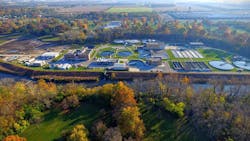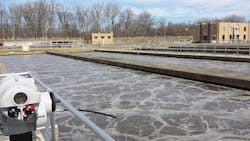For many years, maintaining efficient aeration control was a challenge for the 24 MGD Muncie, Indiana, Water Pollution Control Facility (WPCF). A manually operated system combined with severe mixing-limited conditions resulted in over-aeration and wasted energy. The plant recently alleviated this problem with the CASPERON process and VEMA controller, allowing it to satisfy the needs of the bacteria and mix basin contents while expending less energy.
System Overview
The Muncie WPCF has four banks of aeration basins, each with three passes per bank. In 1983, approximately 9,000 ceramic fine air diffusers were installed in the basins and three 500-hp constant speed centrifugal blowers were added to supply air to the diffusers. From 1983 until 2015 the plant’s aeration system was run manually based on dissolved oxygen (DO) readings.
The Challenge
According to John Barlow, Muncie WPCF Superintendent, operators attempted to maintain DOs in the aeration system just high enough to meet biological demand (2-4 mg/l), with varying degrees of success.
“During the day, filtrate from our belt presses would come back as a recycle stream and knock DO levels down, so we’d have to constantly turn up the blowers by hand and adjust the header valves. By the afternoon, when the belt presses had shut down, DOs would start climbing and we’d have to turn down the blowers and again readjust the header valves,” he says.
Barlow finally made the decision, from both process and operational standpoints, to maintain DO levels in the aeration system between 5 mg/l and 7 mg/l at all times.
“We have a very low, grandfathered electrical rate and no peaking factor, so I decided to run the blowers higher because maintaining the needs of the bacteria is our primary goal,”he says. “We were getting inconsistent ammonia levels in our final effluent due to the roller coaster action from trying to maintain 2-4 mg/l DO levels. Plus, running our operators around all day turning blowers up and down and adjusting header valves was an inefficient use of manpower.”
Adding Automation
To bring efficiencies to the system, the plant upgraded and automated its aeration system as part of a major plant upgrade in 2014. This included the addition of an energy-efficient turbo blower, membrane diffusers, and the OSCAR system with VEMA controller automated control system, which included instruments, control valves, programmable logic controller (PLC) and Human/Machine Interface (HMI).
The original ceramic diffusers were replaced with Xylem Sanitaire Silver Series II membrane disc diffusers for a fine and uniform bubble pattern for oxygen transfer. To support real-time monitoring and control, Xylem YSI instruments were installed in the basins, including FDO dissolved oxygen probes and VARiON ion selective electrode sensors, which measure ammonium, nitrate, and potassium. One ion selective probe was installed per train and one DO probe was installed in each of the three passes of the four trains.
The Sanitaire OSCAR process performance optimizer includes the instrumentation and a biological process control panel that houses a PLC and HMI. The control system uses the DO measurements to automatically adjust the blower speed and air valve position.
“My operations manager can increase or decrease the duration between pulses very easily. It’s a very flexible system.“
VEMA Aeration Controller
Once the upgrade was completed, the aeration system immediately delivered significant energy savings, but high DO levels resulting from severely mixing-limited conditions were an indicator that there was room for additional improvement.
After a short trial to address the mixing limitations that were requiring higher DO levels, Sanitaire implemented the VEMA controller. The controller ensures the basin is continually aerated but allows the air supply rate to be reduced significantly the majority of the time, while maintaining the mixed liquor solids in suspension with intermittent aeration intensity. During its normal operation mode, air supply is based on DO readings to match bacterial demand. For short-sequenced durations, however, the system operates at a higher rate to re-suspend any solids that may have settled during the time it was running at the lower rate.
“We initially struggled to have our DO levels close to where we wanted them to be but still get enough mixing in the tanks so that they didn’t become settling tanks, however our controller’s new program took care of that,” Barlow says. “We now save more than $5,000 per month with the new aeration system, and that’s with our low, grandfathered electrical rate. For 2014, the plant consumed more than 640,000 kilowatt hours and in 2016 it was just over 500,000 kilowatt hours.
Aside from power efficiency, Barlow says there’s more efficient use of staff by having more precise aeration control. “From an operations standpoint, if our operators want to change DOs, they no longer have to manually turn blowers and then adjust 12 different header valves because it’s all automated,” he says. “My operations manager can increase or decrease the duration between pulses very easily. It’s a very flexible system.”
Editor's Note: Scranton Gillette Communications and the SGC Water Group are not liable for the accuracy, efficacy and validity of the claims made in this piece. The views expressed in this content do not reflect the position of the editorial teams of Water & Wastes Digest, Water Quality Products and Storm Water Solutions.

